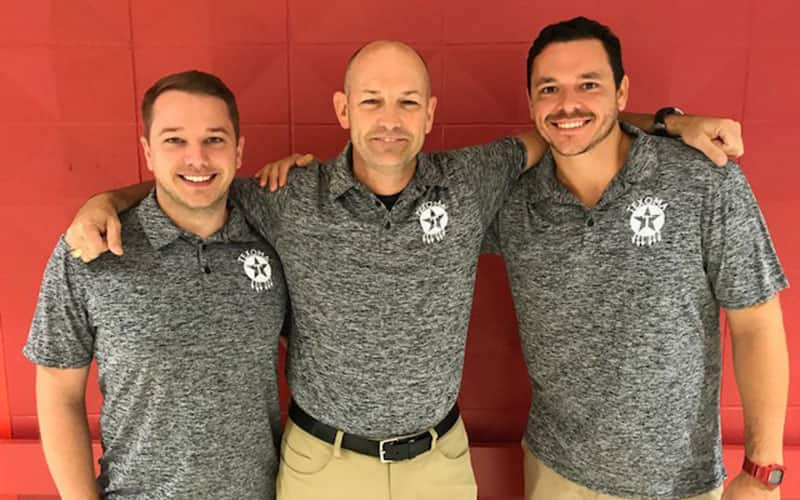
If you aren’t familiar with the Texoma Region, well, that’s because there isn’t one.
However, at the 2018 USA Volleyball High Performance Championships, there are four Texoma rosters on the schedule. Established in 2016 with two teams, Texoma is a combined team from the Oklahoma, North Texas and Lone Star Regions.
The Four Horsemen of Texoma volleyball concept – the originators — are Eric Wooldridge and Sean Carter from Houston Volleyball Academy, Asa Freeman from Dallas and Glen Lietzke, club director at Austin Junior Volleyball.
The program has doubled in size; some players from that first combined effort in 2016 and now on A1 teams at the championships this week in Tulsa.
And the concept has grown to include two teams comprised of players from the Puget Sound, Evergreen and Columbia Empire called Northwest.
What does this mean for America’s Regional Volleyball Associations?
“If you’re in a small region, you can play too,” Carter said.
Why is it important to have a boys presence at this event?
Sean: “For us it’s pretty clear. We’re from a part of the country that doesn’t really get a lot of coverage, and a lot of our athletes don’t get seen by college coaches because we’re not known as a hotbed for that. Texas and Oklahoma are known for football, baseball, not volleyball. So this allows kids from our region to get access to these kind of events where they’re going to have exposure to Division I and II head coaches and get looked at.”
How do you train these guys from three different regions?
Asa: “We do two tryouts. We host the Southwest Boys Tour that has tournaments in every city in our regions in Oklahoma and Texas. We host tryouts the day before and then we decided teams a few weeks later. We had a weekend mini-camp in Dallas, which is the most central location for us, in April. And then we come in a few days early like the USA teams do and we train here. We actually ended up getting 19 hours on the court before the event starts.”
Is there any kind of adjustment that coaches have to make?
Eric: “Constantly. There are athletes from other clubs, so they have different cultures, different systems, some with good systems, some with no systems, so we’re starting from ground zero. But our goal when we’re in the gym with those several hours at the mini-camp is, we are enticing these kids that if we do our job and if you buy into this culture, buy into our system, we will lose you next year. You will be on A1. The system has worked. There are guys on the A1 team who started with us year one. And that’s been really cool to see.”
Are you aware of another group of RVAs has created a combined team?
Sean: “Northwest. I’m excited about that. It’s for all the little guys. If you’re actually trying to develop all of the best talent in the country for your Olympic team, then a high performance system has to be as far and widespread as there are athletes in your country. You better believe that other countries are doing it.
If we’re going to remain competitive up on the podium, we better make sure that we look under every rock we can all over the country whether it’s a traditional hotbed or whether it’s not. So to see that there are now other smaller regions banding together in the Northwest, is a wonderful thing to me.”
Meanwhile in the Puget Sound Region … club coach Paula Schwan of the Kent (Wash.) Juniors Volleyball Club had an idea.
“We’ve been having all the surrounding regions (Evergreen, Columbia Empire) come to our tryouts and our camps for girls’ High Performance,” she said. “For the last several years, we’ve been bringing one or two players from those regions because they don’t have their own region teams.”
This year, with Schwan’s help, Evergreen entered its first HP team.
“I gave them everything we had and I said, ‘this is how you run it’ because we wanted them to be successful. So they had camps for all the age groups for girls and they were able to travel with one youth group.”
But she didn’t stop there. There weren’t enough boys for each region to create a boys’ HP team.
“There’s not enough boys tournaments, there’s not enough multiple-day boys tournaments, where you-even-can-stay-the-night tournaments. All of our regions are in the Northwest, so I brought them all together and said let’s put a team together and call it the Northwest. We want all of the regions to be represented. We just want to build it as much as possible; they have another camp in December.”
Schwan just wants to grow the boys’ game.
“It’s such a fun, dynamic sport,” she said. “I don’t think enough boys who play football, track and baseball have any idea how athletic you must be and coordinated to play this game.”
In Texoma or Northwest, the common thread is just providing an opportunity to get to that next level on the Path to the Podium.
“I think it’s just a stepping stone in building it,” Schwan said. “Hopefully, eventually, it won’t just be a Northwest team; every region will have their own.”

